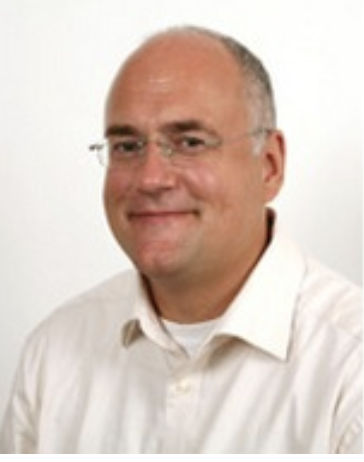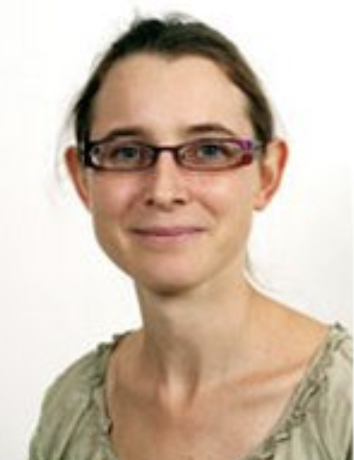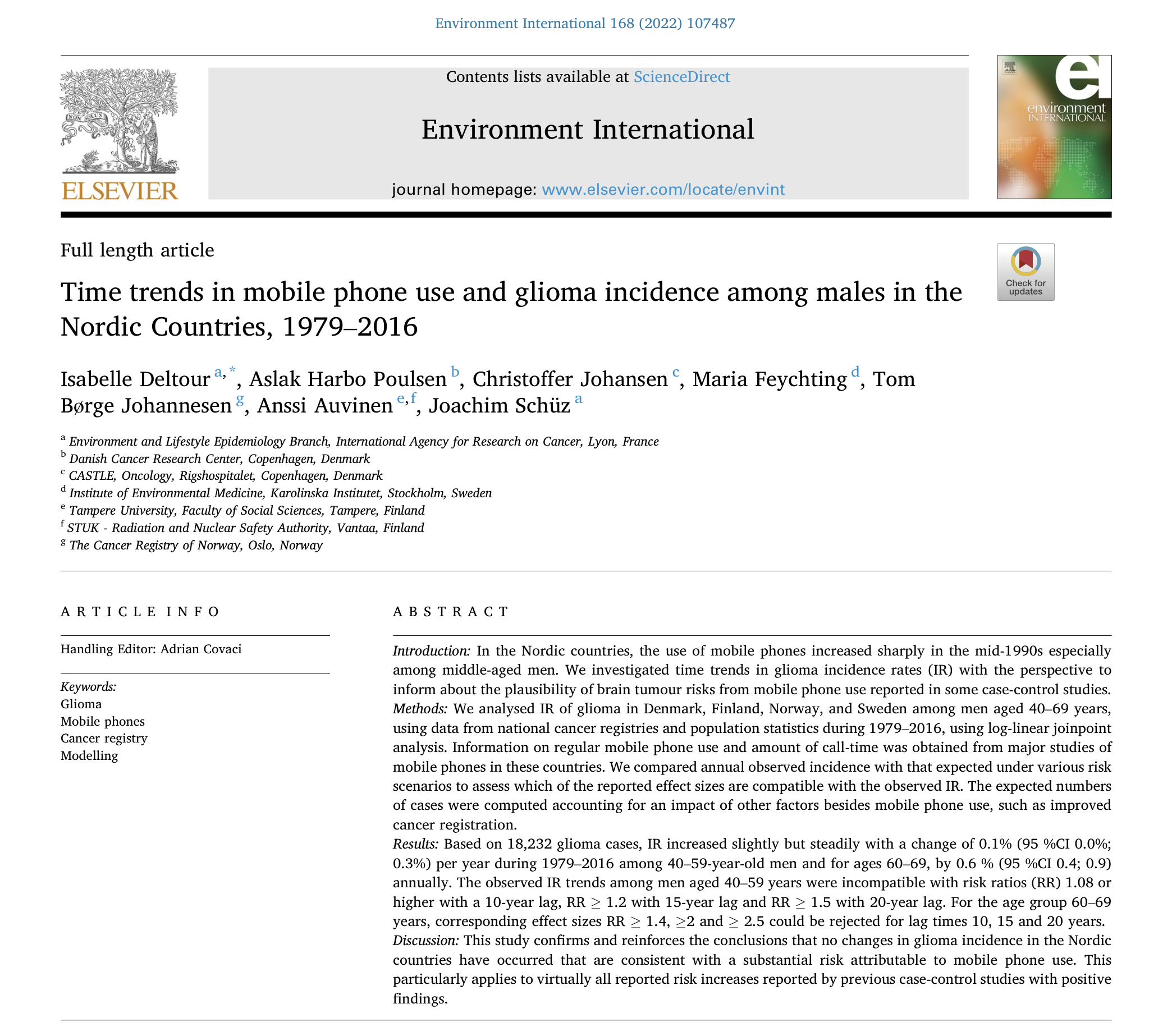IARC on RF: What’s Next?
Own Radiation Group Challenges Basis for “Possible” Cancer Risk
Trends for Aggressive Brain Tumors Unresolved
A new analysis from the radiation group at the International Agency for Research on Cancer (IARC) calls into question the agency’s own classification of wireless radiation as a possible human carcinogen.
On May 27, IARC’s Isabelle Deltour presented the new analysis of the incidence of malignant brain tumors (glioma) in the Nordic countries —Denmark, Finland, Norway and Sweden— over the last several decades. She spoke at an online colloquium hosted by the German Federal Office of Radiation Protection, known as the BfS.
Deltour argued that the trends are mostly not “compatible” with those seen in the epidemiological studies —principally, Interphone and Lennart Hardell’s— that were the basis of IARC’s 2011 designation of RF radiation as a possible, or 2B, human carcinogen.1
Tumor risks associated with the “heavy” use of mobile phones reported in the literature are “mostly not supported,” Deltour concluded.
The IARC project is being run by Joachim Schüz, the head of IARC’s section on environment and radiation in Lyon, France, under a €139,000 (US$160,000) grant from the BfS. Work began in August 2018 and was slated to end in December 2019 but has been delayed. A description of the project is available here and Schüz’s presentation to the BfS in May is here.
Third Time Around
This is the third assessment2 of the Nordic brain tumor data by Deltour, Schüz and others who are now part of the IARC-BfS project. They include Sweden’s Maria Feychting, Denmark’s Christoffer Johansen and Finland’s Anssi Auvinen.
The first two reports, which cover earlier time spans, reached similar conclusions: No increase in brain tumors could be detected as the use of mobile phones was increasing exponentially.
The first paper was published more than a decade ago, two years before the 2011 IARC working group meeting and before the Interphone results were released. It made quite a splash. Headlines all over the world advised that mobile phones are cancer safe. Some epidemiologists were, however, sharply critical of the study. See our story, “Spin, Spin, Spin.”
The unstated subtext of Deltour’s BfS presentation appears to be that the IARC working group’s finding on the RF–cancer risk is no longer justifiable. Because more recent incidence data, which allow for longer latency periods, do not support either the Interphone or the Hardell studies, the 2B classification is without foundation —at least with respect to the available epidemiological studies.


IARC’s Joachim Schüz and Isabelle Deltour
Deltour and Schüz would seem to be swimming against the tide. Their paper comes on the scene at a time when many are calling for IARC to upgrade the risk to probable carcinogen (class 2A) or known carcinogen (class 1).1
In 2019, an IARC advisory group recommended —as a “high priority”— that the agency reassess the risk after the release of the NTP and Ramazzini animal studies, both of which showed increases in tumor counts following long-term RF exposure. The advisory group recommended that the reevaluation be completed between 2022 and 2024.
Briefing at the European Parliament
On May 30, just three days after the BfS colloquium, the European Parliament held a briefing on 5G radiation and health at which Michèle Rivasi, a member from France, called for action. “It is time for IARC to reevaluate the impact of RF radiation on health,” she said.
Fiorella Belpoggi, the lead author of the Ramazzini RF–animal study, was the first speaker at the briefing. She has urged IARC to do a fresh cancer assessment ever since her findings were released in 2018.
Kurt Straif also spoke, and he too favors a new look at the RF-cancer risk. “I fully support the recommendation of the 2019 IARC advisory group,” he told me after the meeting. Straif was in charge of the IARC Monographs program when the RF working group evaluated RF radiation in 2011. He is now with the Barcelona Institute for Global Health (IS Global).
Any reevaluation would include “all eligible and pertinent evidence,” including the cancer epidemiology and the recent animal studies, Straif said.
Just a few weeks ago, Linda Birnbaum, the former director of the U.S. National Toxicology Program, together with a number of public health colleagues, advised the Italian government that when IARC takes the new animal data into account, RF will “certainly” be upgraded to at least a probable and perhaps even a proven human carcinogen. (Details here.)
A date for a new RF working group meeting has not been set, according to Veronique Terrasse in IARC’s Media Center. It would be announced “approximately one year in advance,” she said in an email. This means that it won’t happen before next summer, at the earliest.
As it happens, May 30 was the tenth anniversary of the IARC working group decision to label RF a 2B carcinogen.
By Invitation Only
The IARC-BfS colloquium was a by-invitation-only affair, and Microwave News was not invited. The BfS declined to provide a copy of Deltour’s PowerPoint presentation, as did Deltour and Schüz. Copies of most her 36 slides were however leaked to the Environmental Health Trust (EHT), which passed them on to me. They are available here.
With respect to the general conclusion that the incidence of brain tumors has been stable over many decades (slide 34), there are reasons to interpret this with caution. To wit:
- From 1979 to 2016, incidence rates of brain tumors were “relatively stable” among those 59 years old or younger. But Deltour also stated that the rates among 60-69-year olds and 70-84-year olds were increasing (slide 13). Most brain tumors develop in the older age groups, so this is where you are most likely to see changes in incidence trends.
- Deltour states that the reliability of her analysis is dependent on the “completeness” of the cancer registry data (slide 34). But at least for Sweden, the Nordic country with the largest population and the most cases of brain tumors, the cancer registry has been shown to be substantially incomplete. In fact, this was reported by a member of the Deltour-Schüz study team, Maria Feychting of the Karolinska Institute, not long ago (details here).
Rising Rates of GBM in Denmark and Sweden
Deltour had almost nothing to say about changes in the incidence of low-grade and high-grade brain tumors, notably glioblastoma multiforme (GBM; these are highly aggressive and soon lethal). She mentioned GBMs only once (slide 7), and the point she is making is hard to decipher.
This omission is surprising given the reports, published over the last few years, showing that high-grade tumors are becoming more common in at least two of the Nordic countries —Denmark and Sweden. At the same time, low-grade tumors are declining, leaving the total number of glioma essentially unchanged. This trend was first shown in England by Alasdair Philips in 2018, and confirmed by Frank de Vocht at the University of Bristol.
In a brief email exchange, Schüz told me that his team has incidence data by tumor subtype and that publishing these time trends “is one of our objectives.” He did not elaborate.
I shared Deltour’s PowerPoint with Philips and asked him to comment. Here’s what he told me:
“I think we all can all agree that the overall incidence of glioma is fairly stable. The important question now is: Is something in our environment promoting low-grade gliomas into high-grade GBMs? This appears to be happening in England as well as in other countries. We need to know if this is a real effect or whether it’s due to better imaging and/or changing definitions. That’s what IARC should be working on.”
Canadians Also See No Increase in Glioma
Also late last month, a group in Canada, led by Paul Villeneuve at Carleton University in Ottawa and Daniel Krewski of the University of Ottawa, published its own analysis of glioma trends in Canada between 1992 and 2015. They too found no consistency with the increases predicted by Hardell and the Interphone project, including its Canadian component.
In their paper, Villeneuve and Krewski cite Philips’s suggestion that cell phones may be causing more aggressive tumors to develop. They, like Deltour, do not present any glioma subtype data. I asked Villeneuve why. He replied that investigating those trends was outside the primary objective of the project. This is “worthy of further research,” he added.3
Villeneuve pointed out that he had submitted his paper for publication in 2019. It had been delayed until now, he said, because much of Canada had closed down due to the COVID pandemic.
Alumni of the Danish Cohort Study
It’s tempting to call the new IARC-BfS analysis the Revenge of the Danish Cohort Study.
Like the glioma trends project, the cohort study comes in three parts, and it too purports to show no brain tumor risks following the introduction of mobile phones. Schüz is the lead author of the two most recent updates, published in 2006 and 2011.
The first results of the cohort study came out in 2001. Christoffer Johansen, a member of the current Schüz-Deltour project, is the lead author. At the time, Johansen was at the Danish Cancer Society in Copenhagen, where Schüz and Deltour also used to work before moving to IARC about ten years ago.
Schüz often cites the cohort study to support his widely shared skepticism of possible cancer risks from what he calls the “normal” use of a mobile phone. He spoke at the European Parliament meeting on May 30 and reiterated this view. Later in his talk, he acknowledged some uncertainty. “The cancer question still has to be resolved,” he allowed.
Ironically, back in 2011, IARC’s own RF working group rejected the findings of the Danish Cohort Study in favor of those of Interphone and Hardell, which do show a cancer risk. This decision was largely due to the cohort study’s fundamentally flawed exposure assessment —those with the heaviest cell phone use are in the control group! (More here.)
No Word on Publication Schedule
In a message to those invited to her BfS talk, Deltour said that her report on the Nordic glioma analysis is nearing completion and “will be published soon —the report is in finalization phase as soon as possible.”
When asked when and where it would appear, neither she nor Schüz would be more specific. “We will for sure publish our results but otherwise we are not in a position to share details about work in progress,” Deltour replied by email.
IARC is an agency of the World Health Organization (WHO).
IARC Brain Tumor Report Issued by BfS
July 7, 2022
The BfS has released a report for its IARC project on brain tumor incidence in the Nordic countries led by Isabelle Deltour and Joachim Schüz: Use of Mobile Phones and the Incidence of Glioma Since 1979. The 69-page report, which is mostly in English, is open access.
Here are the principal conclusions (pp.22-23), with emphasis added:
“In this project we projected incidence rates of glioma under various scenarios of mobile phone-associated increased glioma risks and compared them with the observed incidence rates in the Nordic countries. The comparison was carried out on the data of men aged 40 to 69 years.”
“The modelled scenarios included risk increases reported from analytical epidemiological studies, which were all of case-control design. Most of those results were shown to be implausible in our simulations, implying that biases and errors in the self-reported use of mobile phones have likely distorted their findings. An increased risk in the 10% heaviest mobile phone users was an exception to this general situation, as it remained plausible.”
“Results of cohort studies showing no association were compatible with observed incidence rates.”
“We also studied what hypothetical mobile phone-related risks were conceivable if the changes in incidence rates in 40–59-year-old and 60-69-year-old men were fully attributable to mobile phone use. The fact that we observed different hypothetical risks in these two age groups while research at present has not suggested that older men should have higher risk related to mobile phone use than younger men, does not align with the assumption that mobile phone exposures caused the incidence rate trends.”
“This ecological data is not sufficient to dismiss every potential mobile phone related risk scenario but suggests that the risk —if it exists— would be very small, only occur after very long latency periods of several decades, or only affect small subgroups within glioma patients.”
The report includes an analysis of glioma subtypes, but it is limited due to the lack of available data and changes in tumor codes. Here’s the summary of the subtype analysis (pp.15-16):
“The analysis by subgroups of tumor types could be performed only for the period 1990-2016 for reasons of data availability: in Sweden, a separate code for glioblastoma did not exist prior to 1993, and very few of the tumors which had been diagnosed during the period 1990-1992 were retrospectively coded into this code. Indeed, cancer registries are continuously updated when additional information becomes available on an earlier diagnosis, for example.”
“Among men and women, the rates of glioblastomas increased in the last years of observations, while the rate of other high-grade gliomas decreased (Table 8 and Table 9). Rates of low- grade gliomas were relatively stable in all countries since the mid 1990’s except in Denmark, where substantial increases were noted towards the end of the period of observation, albeit non-significant.”
IARC Paper Published
August 24, 2022
The Deltour-Schüz paper, “Time Trends in Mobile Phone Use and Glioma Incidence Among Males in the Nordic Countries, 1979-2016” has been published in Environment International. Among the coauthors are Finland’s Anssi Auvinen, Sweden’s Maria Feytching and Denmark’s Christoffer Johansen. It is open access.
Among their conclusions is this: “[I]ncreased risks reported in some case-control studies are implausible and likely attributable to biases and errors in self-reported use of mobile phone.”
________________________
FOOTNOTES
1. IARC evaluations —spelled out in its Monographs— are considered the gold standard on the identification of cancer agents. The first volume, on a number of different chemicals, appeared in 1972. RF radiation is Volume 102. More about IARC Monographs here and more on IARC classifications here.
2. Deltour is also the first author of the two previous papers. The first, which appeared in the Journal of the National Cancer Institute in 2009, covered 1974-2003. It has many of the same authors as are on the IARC-BfS team. The second covers 1979-2008; it was published in the journal Epidemiology in 2012.
3. In late 2019, Faith Davis of the University of Alberta, in Canada, reported that the incidence of GBM, though rising slowly over the last 20 years, has not jumped up in the U.S. and Canada, as it has in England. Story here.

